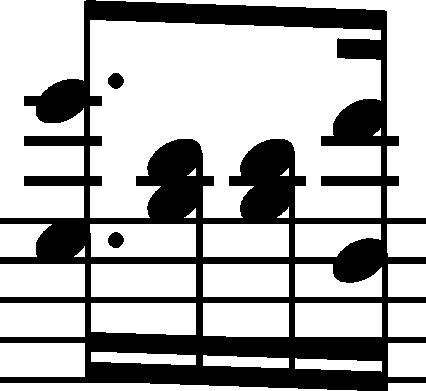



Issues : Errors in FE
|
b. 8
|
composition: Op. 44, Polonaise in F♯ minor
..
In FE1 the last two R.H. dyads are c category imprint: Differences between sources issues: EE revisions , Errors in FE , Terzverschreibung error , FE revisions |
|||||
|
b. 10
|
composition: Op. 44, Polonaise in F♯ minor
..
The category imprint: Differences between sources issues: Annotations in teaching copies , EE revisions , Errors in FE , Placement of markings , Annotations in FES |
|||||
|
b. 13-15
|
composition: Op. 44, Polonaise in F♯ minor
..
In FE (→EE) the crotchet stems reach only the top notes of the R.H. octaves on the 2nd beat of b. 13 and 14; similarly, in b. 15 it is only the top notes of the octaves that are separated as the top voice on the 3rd beat (in turn, both notes of each of those octaves belong to the bottom voice). It must have resulted from a misunderstanding: Chopin's notation was misunderstood by the copyist or, which is more likely, by the engraver of FE. Chopin would always write stems on the right-hand side of noteheads, which would result in an ambiguous notation in such a situation, e.g. in b. 15: category imprint: Interpretations within context; Differences between sources issues: EE revisions , Errors in FE , Errors in GE , FE revisions |
|||||
|
b. 15
|
composition: Op. 44, Polonaise in F♯ minor
..
In FE1 the top notes of the 7th and 8th R.H. semiquavers were printed a second higher (by mistake). Consequently, the 4 last octaves in this bar sound as follows when interpreted literally: d category imprint: Differences between sources issues: EE revisions , Errors in FE , FE revisions |
|||||
|
b. 20
|
composition: Op. 44, Polonaise in F♯ minor
..
The lack of hairpin The lack of hairspin category imprint: Differences between sources issues: Errors in FE |

 3-a3 sixths. This patent mistake was corrected in
3-a3 sixths. This patent mistake was corrected in  over g
over g . The fact that Chopin meant to prolong both notes of the octaves is evidenced by the dots prolonging both notes in
. The fact that Chopin meant to prolong both notes of the octaves is evidenced by the dots prolonging both notes in  in
in